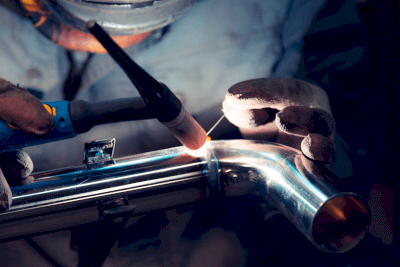What Is a TIG Welding Service?

A TIG welding service is a type of arc welding that uses heat from an arc to weld a workpiece.
TIG is an acronym for Tungsten Inert Gas. A tungsten electrode is used for the welding electrode and an inert gas such as Ar or He is used for the shielding gas.
In MAG welding, which uses active gas as the shielding gas, metals that react with active gas, such as aluminum, cannot be welded.
The high heat of arc discharge generated by TIG welding reaches 11,000°C at the center of the spark, making it possible to process any metal. Shielding gas such as argon or helium gas is used to prevent spattering and ignition during welding.
A TIG welding service is an easy-to-use welding method for beginners because it does not produce sparks and is quieter than conventional EDM.
Uses of TIG Welding Services
1. Uses of DC Welding
- When joining products where the aesthetics of the welded part is important.
- When welding stainless steel pipes, sheets, etc. by individuals.
- When welding wheel parts, muffler parts, etc. at automobile repair stores and motorcycle stores.
2. Uses of AC Welding
AC TIG welding services are used when processing metal sheets such as aluminum and magnesium, etc., on which surface oxide film is formed.
Principle of TIG Welding Services
TIG welding services are similar to general arc welding, in which a high voltage is applied between the electrode and the base metal to break down the insulation between the electrode and the base metal, and then an arc current flows. In TIG welding, thermionic emission from the tungsten electrode is used, so basically the electrode is often used as the cathode and the base material as the anode.
In MAG welding, welding proceeds as the electrode melts. However, in TIG welding services, the electrode is basically used only to supply electrons.
Types of TIG Welding Services
There are two types of TIG welding services, depending on the combination of current used and electrode polarity.
1. Direct Current Welding
DC Positive polarity
As described in the TIG welding services principle, when welding with DC positive polarity, electrons emitted from the electrode side (cathode) reach the workpiece side (cathode), resulting in a very high temperature on the workpiece surface. Direct current welding is a method of welding metals by means of high heat.
DC Reverse Polarity
This welding method enables the welding of metals with oxide films on their surfaces, such as aluminum and magnesium, which cannot be processed with DC-positive polarity. In both of the above metals, oxide films with high melting points (>2000°C ) exist on the metal surface. Therefore, if TIG welding services are executed without measures to prevent oxide film, the temperature difference between the metal surface and the metal interior becomes too large to weld the workpiece.
To solve this problem, reverse polarity welding is a method in which the electrode polarity is reversed, with the positive (⊕) pole on the electrode side and the negative (⊖) pole on the workpiece side. By welding with reverse polarity, the oxide film on the surface of the base metal can be removed (cleaning action).
However, when the polarity is reversed, a large number of electrons collide with the electrode, resulting in significant electrode wear. In addition, since the cathode spot moves around, the heat input to the base material is dispersed and the amount of penetration is reduced. As a result, it is not possible to perform high-quality welding with DC reverse polarity.
2. AC Welding
AC welding is a welding method in which the polarity of the electrode is cyclically converted, alternating between DC positive and DC reverse polarity. High-quality welding by DC positive polarity and cleaning action by DC reverse polarity can be used together. It is possible to suppress electrode wear caused by DC reverse polarity.
Other Information on TIG Welding Services
Advantages and Disadvantages of TIG Welding Services
The following is a summary of the advantages and disadvantages of TIG welding services based on the explanations given so far.
Merits
- Almost all metals can be welded.
- No sparks are produced during welding.
- Low work noise.
- Beautiful weld bead (weld finish).
- Welding can be done in any posture.
Disadvantages
- Poor welding efficiency.
- Inert gas is expensive.
- Shielding gas is used, so measures such as wind protection are necessary.
- Welding quality depends greatly on the skill of the welder.